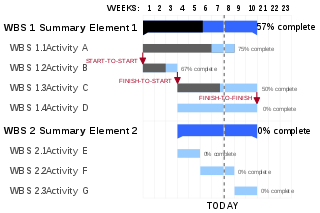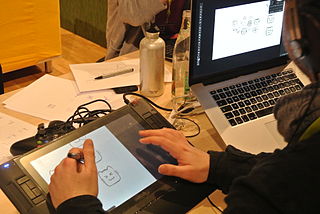
A graphical user interface, or GUI, is a form of user interface that allows users to interact with electronic devices through graphical icons and visual indicators such as secondary notation. In many applications, GUIs are used instead of text-based UIs, which are based on typed command labels or text navigation. GUIs were introduced in reaction to the perceived steep learning curve of command-line interfaces (CLIs), which require commands to be typed on a computer keyboard.

The history of the graphical user interface, understood as the use of graphic icons and a pointing device to control a computer, covers a five-decade span of incremental refinements, built on some constant core principles. Several vendors have created their own windowing systems based on independent code, but with basic elements in common that define the WIMP "window, icon, menu and pointing device" paradigm.

An operating system (OS) is system software that manages computer hardware and software resources, and provides common services for computer programs.

Computer-Aided Design (CAD) is the use of computers to aid in the creation, modification, analysis, or optimization of a design. This software is used to increase the productivity of the designer, improve the quality of design, improve communications through documentation, and to create a database for manufacturing. Designs made through CAD software help protect products and inventions when used in patent applications. CAD output is often in the form of electronic files for print, machining, or other manufacturing operations. The terms computer-aided drafting (CAD) and computer-aided design and drafting (CADD) are also used.

Lisa is a desktop computer developed by Apple, released on January 19, 1983. It is generally considered the first mass market personal computer operable through a graphical user interface (GUI). In 1983, a machine like the Lisa was still so expensive that it was primarily marketed to individual and small and medium-size businesses, as a groundbreaking new alternative to much bigger and more expensive mainframes or minicomputers such as from IBM, that either require additional, expensive consultancy from the supplier, hiring specially trained personnel, or at least, a much steeper learning curve to maintain and operate. Earlier GUI-controlled personal computers were not mass marketed; for example, the Xerox Alto was manufactured in several thousands only for Xerox and select partners through Xerox PARC from the early to mid 1970s.

The critical path method (CPM), or critical path analysis (CPA), is an algorithm for scheduling a set of project activities. A critical path is determined by identifying the longest stretch of dependent activities and measuring the time required to complete them from start to finish. It is commonly used in conjunction with the program evaluation and review technique (PERT).
Project management software (PMS) has the capacity to help plan, organize, and manage resource tools and develop resource estimates. Depending on the sophistication of the software, it can manage estimation and planning, scheduling, cost control and budget management, resource allocation, collaboration software, communication, decision-making, quality management, time management and documentation or administration systems. Numerous PC and browser-based project management software and contract management software products and services are available.

A Gantt chart is a bar chart that illustrates a project schedule. It was designed and popularized by Henry Gantt around the years 1910–1915. Modern Gantt charts also show the dependency relationships between activities and the current schedule status.

A/UX is a Unix-based operating system from Apple Computer for Macintosh computers, integrated with System 7's graphical interface and application compatibility. It is Apple's first official Unix-based operating system, launched in 1988 and discontinued in 1995 with version 3.1.1. A/UX requires select 68k-based Macintosh models with an FPU and a paged memory management unit (PMMU), including the Macintosh II, SE/30, Quadra, and Centris series.
MacWrite is a WYSIWYG word processor application released along with the first Apple Macintosh systems in 1984. Together with MacPaint, it was one of the two original "killer applications" that propelled the adoption and popularity of the GUI in general, and the Mac in particular.
MultiFinder is an extension for the Apple Macintosh's classic Mac OS, introduced on August 11, 1987 and included with System Software 5. It adds cooperative multitasking of several applications at once – a great improvement over the previous Macintosh systems, which can only run one application at a time. With the advent of System 7, MultiFinder became a standard integrated part of the operating system and remained so until the introduction of Mac OS X.

The Apple Macintosh—later rebranded as the Macintosh 128K—is the original Apple Macintosh personal computer. The Macintosh was the first successful mass-market all-in-one desktop personal computer with a graphical user interface, built-in screen, and mouse. It played a pivotal role in establishing desktop publishing as a general office function. The motherboard, a 9 in (23 cm) CRT monitor, and a floppy drive were housed in a beige case with integrated carrying handle; it came with a keyboard and single-button mouse. It sold for US$2,495. The Macintosh was introduced by a television commercial entitled "1984" shown during Super Bowl XVIII on January 22, 1984 and directed by Ridley Scott. Sales of the Macintosh were strong at its initial release on January 24, 1984, and reached 70,000 units on May 3, 1984. Upon the release of its successor, the Macintosh 512K, it was rebranded as the Macintosh 128K. The computer's model number was M0001.

Digital painting is an art medium created with computer technologies. It employs pixels which are assigned a color to create imagery. It is also known as raster graphics. It is called digital painting because it initially distinguished itself from vector graphics in its ability to render gradiated or blended colors in imagery which mimicked traditional drawing and painting media.

MacProject was a project management and scheduling business application released along with the first Apple Macintosh systems in 1984. MacProject was one of the first major business tools for the Macintosh which enabled users to calculate the "critical path" to completion and estimate costs in money and time. If a project deadline was missed or if available resources changed, MacProject recalculated everything automatically.

In computing, a shell is a computer program that exposes an operating system's services to a human user or other programs. In general, operating system shells use either a command-line interface (CLI) or graphical user interface (GUI), depending on a computer's role and particular operation. It is named a shell because it is the outermost layer around the operating system.

FastTrack Schedule is a Project Management Software app (PMS) for Mac and Windows. It helps teams plan, track, analyze, organize, manage resources, develop resource estimates, and report their projects. It can manage planning, scheduling, cost control, budget management, resource allocation, and Project Portfolio Management (PPM).
Two major families of Mac operating systems were developed by Apple Inc.
The following outline is provided as an overview of and topical guide to project management:

Mac OS is the series of operating systems developed for the Macintosh family of personal computers by Apple Computer from 1984 to 2001, starting with System 1 and ending with Mac OS 9. The Macintosh operating system is credited with having popularized the graphical user interface concept. It was included with every Macintosh that was sold during the era in which it was developed, and many updates to the system software were done in conjunction with the introduction of new Macintosh systems.
Comparison of user features of operating systems refers to a comparison of the general user features of major operating systems in a narrative format. It does not encompass a full exhaustive comparison or description of all technical details of all operating systems. It is a comparison of basic roles and the most prominent features. It also includes the most important features of the operating system's origins, historical development, and role.













